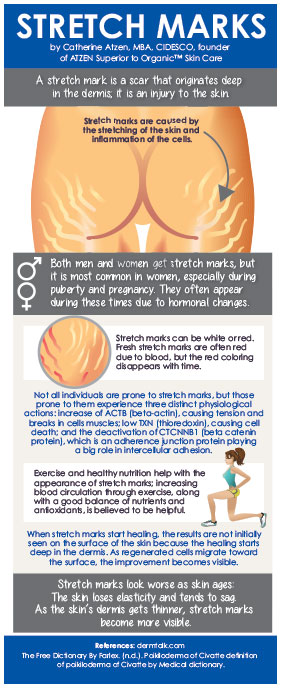• A stretch mark is a scar that originates deep in the dermis; it is an injury to the skin.
• Stretch marks are caused by the stretching of the skin and inflammation of the cells.
• Both men and women get stretch marks, but it is most common in women, especially during puberty and pregnancy. They often appear during these times due to hormonal changes.
• Stretch marks can be white or red. Fresh stretch marks are often red due to blood, but the red coloring disappears with time.
• Exercise and healthy nutrition help with the appearance of stretch marks; increasing blood circulation through exercise, along with a good balance of nutrients and antioxidants, is believed to be helpful.
• Stretch marks look worse as skin ages: The skin loses elasticity and tends to sag. As the skin's dermis gets thinner, stretch marks become more visible.
• Not all individuals are prone to stretch marks, but those prone to them experience three distinct physiological actions: increase of ACTB (beta-actin), causing tension and breaks in cells muscles; low TXN (thioredoxin), causing cell death; and the deactivation of CTCNNB1 (beta catenin protein), which is an adherence junction protein playing a big role in intercellular adhesion.
• When stretch marks start healing, the results are not initially seen on the surface of the skin because the healing starts deep in the dermis. As regenerated cells migrate toward the surface, the improvement becomes visible.

Want to read more?
Subscribe to one of our monthly plans to continue reading this article.